Wi-Fi Site Surveys, Analysis, Troubleshooting runs on a MacBook (macOS 11+) or any laptop (Windows 7/8/10/11) with a standard 802.11be/ax/ac/n/g/a/b wireless network adapter. Read more about the 802.11be support here.
Using NetSpot for Easy WiFi Detection
NetSpot is an easy-to-use wireless network detector app for Mac.
NetSpot can help you to take a quick snapshot of the Wi-Fi networks around you. In addition, you can also use it to do a complete site survey of your entire wireless network area.
Wi-Fi detection is useful for many different situations, such as:
- When you're traveling and need to find an open network to connect to.
Inspector shows a Security Type column (Open, WEP, WPA, WPA2). Sort networks by Security Type, glance at Signal Level, and you instantly see which hotspots are unsecured and which of them deliver a rock-solid signal (anything around −50 dBm). No more trial-and-error log-ins while you juggle a latte in the airport café. - When you wish to test the limits of your Wi-Fi network's range and locate the exact point where the signal fades.
Walk away from the router and look at the live Signal Level read-out and its mini graph. Values from -62 dBm up to about -10 dBm are plotted in green (rock-solid connection). Between -79 dBm and -62 dBm the trace turns yellow, warning that performance is borderline and likely to drop under load. Anything from -96 dBm up to -79 dBm shows up in red, marking true dead zones where reliable transfer stops. - When sluggish performance suggests interference from nearby networks.
Сheck the Channel and Band columns. For example, if your router uses 2.4 GHz channel 6 and Inspector lists several strong neighboring SSIDs on the same channel, you’re staring at co-channel congestion. Switch to less crowded channel (1 or 11) or migrate to 5 GHz; if the Inspector's Mode column shows your hardware supports Wi-Fi 6E, hopping to 6 GHz clears the air even more.
Inspector Mode gives you immediate insight into your wireless surroundings, clearly presenting crucial Wi-Fi parameters at a glance. By highlighting key metrics guides you toward informed, practical solutions — whether you're traveling, testing network boundaries, or resolving connectivity problems. Regularly consulting Inspector Mode helps maintain optimal Wi-Fi performance and stability in any situation.
How to Use a Wireless Network Detector
Using NetSpot as a WLAN detector is easy. Simply install the NetSpot app and place your MacBook in the area you wish to survey. Once the program has loaded, click the switch in the upper-left corner of the screen to change it from "Survey" to "Inspector". NetSpot will immediately detect all the networks in range and display them on screen.
At a glance you will be able to see specific details about each wireless network detected in the area, including:
- SSID — the name of the network
- Channel — the channel the network is broadcasting on (1, 6, 11, etc.)
- Band – the band the network is broadcasting on (2.4 GHz, 5 GHz, 20 MHz, 40 MHz)
- Security Type — the kind of security the network has (WEP, WPA, WPA2, etc.)
- Mode — which 802.11 protocol the network has 802.11a/b/g/n/ac/ax
- Level (SNR) — the network's Signal-to-Noise Ratio level
- Signal level — how strong the network's signal is
- Noise level — how much noise is interfering with the network
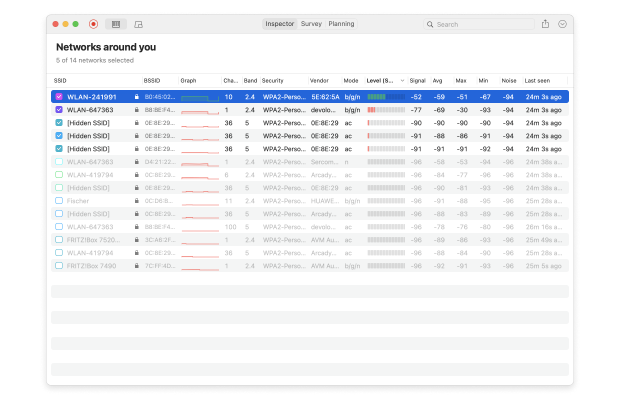
How To Use NetSpot for a Full WLAN Site Survey
If you wish to get a more complete picture of your wireless network, you can use NetSpot to do a complete site survey. This will allow you to perform WLAN detection at various points throughout your network area.
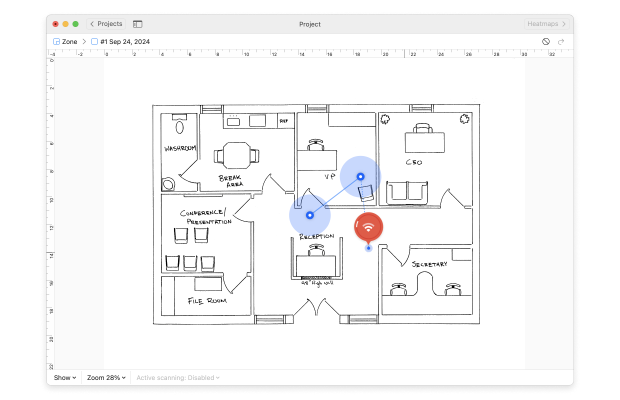
If you have not used NetSpot before, read "How Do I Start My Survey?" before starting. Next, identify the area you wish to perform Wi-Fi detection on and upload a map of the area. You could also draw a map using NetSpot's map drawing tools.
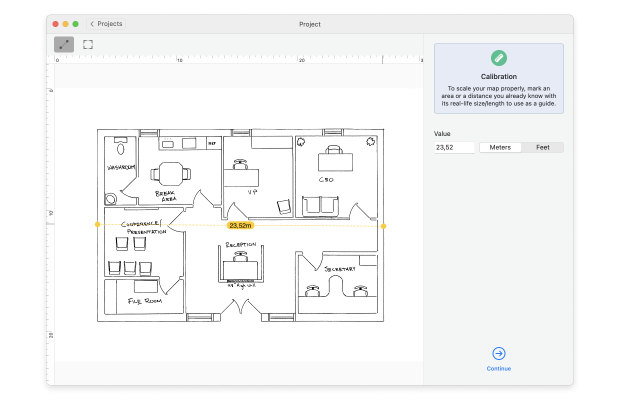
Then proceed with your survey, taking data measurements throughout the network area. Once you complete your survey, you will be able to view heatmap visualizations.
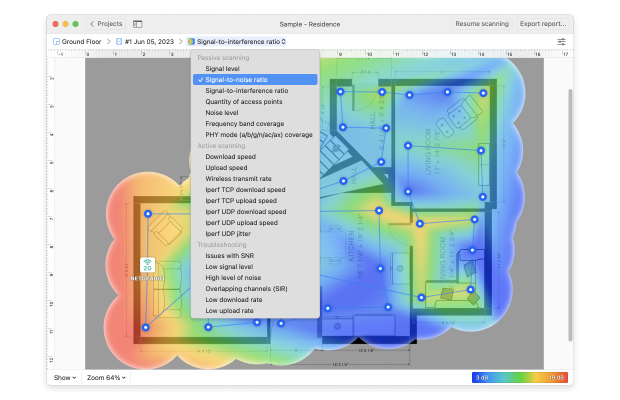
NetSpot's visualizations will allow you to see your signal strength, signal-to-noise ratio and signal-to-interference ratio coverage throughout the area you surveyed. There is also an AP Quantity visualization that will show you how many APs (access points or routers) are detected at every measurement point. NetSpot takes care of all of your wireless network detection needs.
NetSpot Wi-Fi troubleshooter helps you
- Free Wi-Fi interference detector
- Best free Wi-Fi detector
- WiFi hotspot detector
- Detector of all wireless network
- Wireless network detector
- WiFi networks detection for Mac
WiFi Detector FAQs
NetSpot is a great WLAN detector — install the app and take your laptop to the area you wish to survey. Open NetSpot, click the switch in the upper-left corner to go to "Inspector" mode. NetSpot will detect all networks in range and display them.
You'll be able to see the following information:
- SSID — the name of the network;
- Channel — the channel the network is broadcasting on;
- Band — the frequency band the network is broadcasting on;
- Security Type — the security protocol network is using (WEP, WPA, WPA2, etc.);
- Mode — the type of 802.11 protocol network is using(a/b/g/n/ac/ax);
- Level (SNR) — network's Signal-to-Noise Ratio value;
- Signal level — the strength of network's signal;
- Noise level — the level of noise in the area of coverage.
To survey your WiFi network site, upload the map of the area and start taking the measurements throughout. Once the survey is complete you'll be able to view heatmaps of the area.
With the visual assistance of heatmaps you'll be able to assess the signal strength, signal-to-noise ratio and signal-to-interference ratio in the surveyed area. You can also see how many access points are installed.
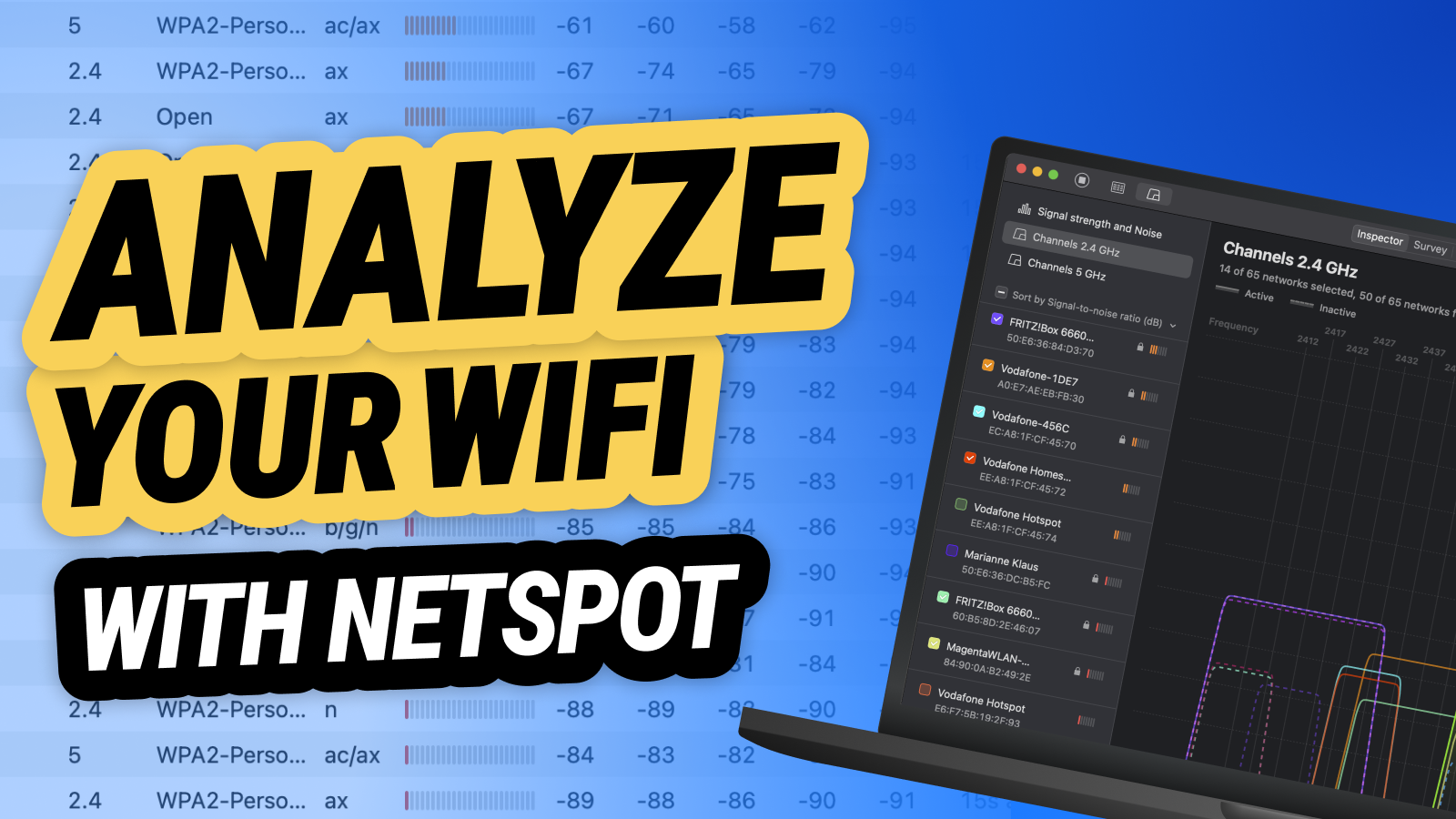

NetSpot takes care of all of your wireless network detection needs